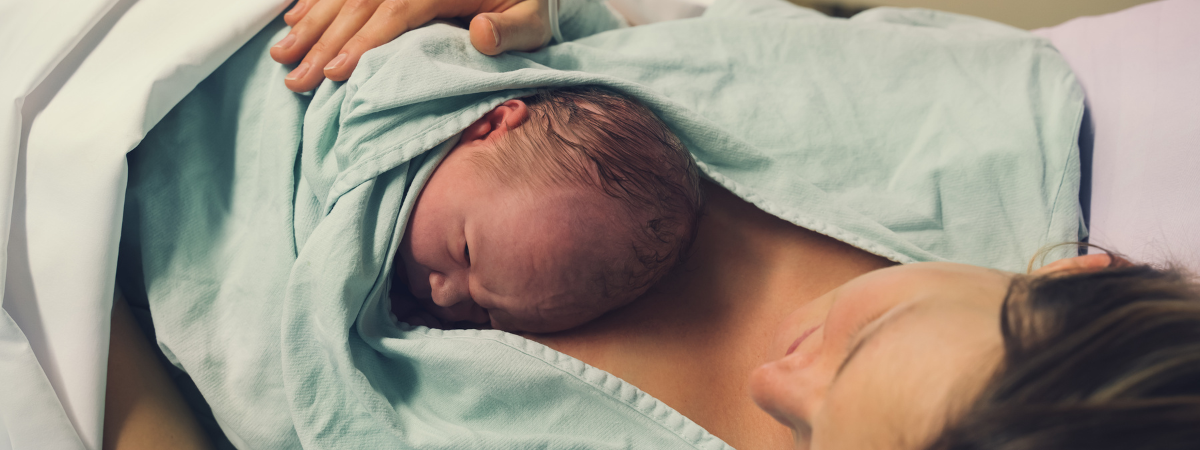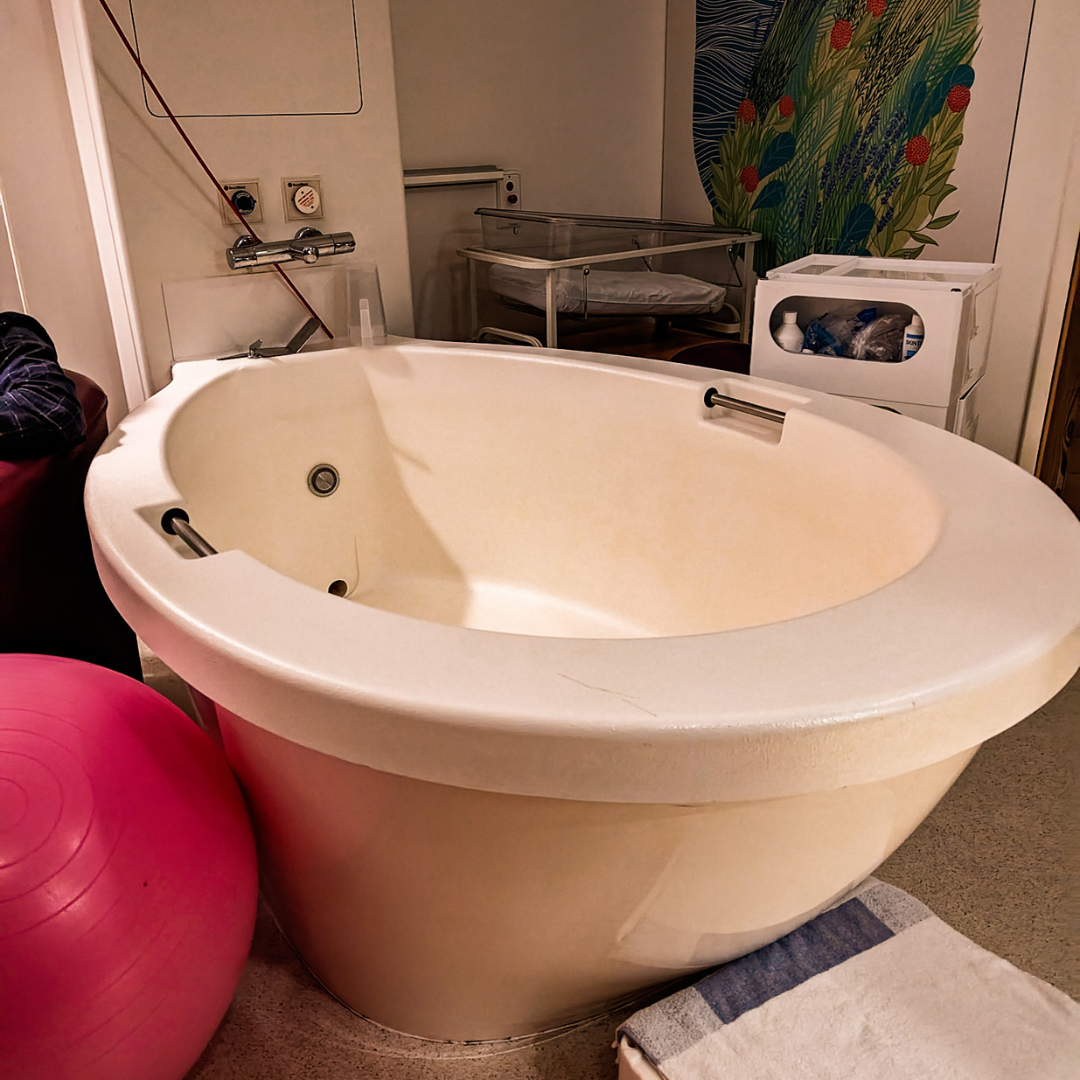Hoping for a water birth in a birth centre? Kingston, St. George's, Chelsea & Westminster, St Thomas’ and St. Helier all have them – but what do you need to know?
First things first… how to access a birth centre!
When I chat to potential doula clients in discovery calls, I always ask what kind of birth they’re hoping to have. Probably 75% of the time, the answer is “a water birth on a birth centre.” So I thought it would be helpful to share what I tell them: first about how to maximise your chances of a water birth in a birth centre, and then some inside intel on the different birth centres near you in South West London.
How to Access a Birth Centre for Your Water Birth
Most parents I speak to during pregnancy are worried about whether a pool will be available when they arrive at the birth centre, but I always explain that it’s really more important to focus your energies on getting onto the birth centre in the first place! Most hospitals don’t discuss birth choices with you until 36 weeks, but it’s good to be preparing and working out your options earlier on in pregnancy so you can advocate for what you want at this appointment. You can sometimes watch virtual tours of the local South West London birth centres online, or even better, go and visit on an in-person tour (offered routinely at St George’s and St Helier), or ask to be shown around.
If your pregnancy is “low risk,” then giving birth on the birth centre would be supported by your hospital. However, it’s not unusual for “risk factors” to be identified in your pregnancy. In my experience, many of these come up near the end of pregnancy, not giving you much time to consider them. It would be impossible to go through all scenarios now, which is where the support of a good doula can help – so you don’t feel like you always need to be one step ahead! But there are many sources of quality information out there for you to research yourself. I would really recommend the work of Dr. Rachel Reed, Sara Wickham, AIMS, and the podcast The Great Birth Rebellion.
Local Birth Centre and Water Birth Statistics
Using data from the National Maternity Dashboard and individual stats from each birth centre, here’s what you can find:
- St Helier (Feb 2025): 14% of all babies born on the birth centre, 6% of all births were water births on the birth centre
- Kingston (Dec 2024): 15% of all babies born on the birth centre, 7% of all births were water births on the birth centre
- St George’s (Jan 2025): 4% of all babies born on the birth centre, 0.8% of all births water births on the birth centre
- Chelsea & Westminster (Dec 2024): 14% of all babies born on the birth centre, no water birth figures available
We can also see from the statistics that you are more likely to use a birth centre for a second or subsequent birth rather than for your first (about 30–40% of mums giving birth on the birth centre are first-time parents).
Therefore, the hospital published statistics suggest that around 15% of women birth on the birth centre, and around half in water. I always make it clear that I say this to encourage, rather than discourage: this knowledge is power. It makes it clear that to aim for the birth you want, you can’t just go with the flow of NHS maternity care, because the flow is taking you in a different direction – onto the labour ward (NB: some labour wards also have pools, but there are no published statistics on how often women have water births on labour ward).

Understanding Water Birth Use in Birth Centres
In terms of having a water birth specifically, we can see from the statistics above that less than 50% of women using a birth centre actually give birth to their baby in the water (although many still use the pool for pain relief). In some cases, this is due to maternal preference, or simply because there wasn’t time to fill the pool. Or you may be told that you can use the birth centre but not the birth pool; in these cases, you would need to look into the evidence for this recommendation during your pregnancy.
There are some reasons why you may be asked to get out of the pool during labour, and this NHS document has a helpful list:
- To use the toilet
- For additional pain relief
- If there is any evidence of meconium staining
- If there is difficulty in hearing your baby’s heart rate or any irregularity in the baby’s heart rate
- For internal vaginal examinations
- If your blood pressure, pulse or temperature becomes abnormal
- If your labour does not progress as expected
- In order to deliver the placenta
These are all topics you would need to research and decide what you think about (remember, in birth, all care and recommendations are offers, not orders!). It’s best to do this in advance of your labour for the greatest chance of making an informed decision at the time.
Birth Centre Access When You’re “Out of Guidance”
Each birth centre in South West London has its own policies on who meets the criteria to use them. If you meet the criteria, you wouldn’t usually face any barriers to going to the birth centre in labour – although it still may not be proactively offered, so make sure you know what’s available so your birth partner can ask for what you want at the time. You may be asked or may choose to transfer to the labour ward during your labour, and the points listed above about reasons to get out of the pool are also the kinds of things you would want to know about when making a decision on this.
If you don’t meet the criteria, you may be told that you’re not allowed to birth on a birth centre. However, the reality is much more nuanced than that. This article from BirthRights gives an amazing explanation, but the simple answer is that we have a right to choose where we give birth. The only reason you can be refused access to a birth centre is if there is a good evidence-based reason that you or your baby cannot be provided safe care there.
One major reason for being discouraged from using a birth centre is a recommendation for continuous fetal monitoring (CTG) in labour. However, there is very little evidence that this improves outcomes for babies, and only in very specific circumstances: I recommend reading some of the amazing work from Dr. Kirsten Small on this topic. Therefore, if you are comfortable with declining the offer of continuous monitoring in labour, this alone would not be an evidence-based reason to deny you access to a birth centre.
If you want to birth on a birth centre near you when you don’t meet the criteria, ask to speak to a consultant midwife to make an “out of guidance” birth plan to use the birth centre. This must be done before you go into labour to ensure a smooth and well-supported journey for you and your baby when you arrive at the hospital.

Reviews of Local Birth Centres in South West London
It’s finally time to have a chat about the ins and outs of our local birth centres! Here are some of my observations after supporting women as a doula at all our local birth centres:
Location of the birth centre relative to the labour ward
Kingston, St. George’s, Chelsea & Westminster, St Thomas’ and St. Helier all have alongside birth centres, meaning they’re in the same hospital building as the labour ward. This gives you easy access to obstetric care if you need or want it during your labour. At Kingston, St. Helier and St Thomas's, the birth centres are literally adjacent to the labour ward; at Chelsea and Westminster they’re on the same floor but across the corridor, and at St. George's they’re two floors apart. I wouldn’t say any of these factors has a major impact if you decide to transfer in labour.
Staffing levels
Almost all our local South West London hospitals are able to reliably staff their birth centres, which isn’t always the case across the UK – so we’re lucky to have this provision. It’s unlikely that if you arrive (and are eligible to access their facilities – see above!) that there wouldn’t be space for you. It’s always sensible to ring in early labour, so you know what availability is like and in some cases can make a decision about your timing of going in. The slight exception to this is St. George's – the latest statistics available from Jan 2025 say the birth centre was open 82% of the time. This is an improvement on recent years, and I know the staff are very motivated to raise the profile and availability of the birth centre. They also confirmed that they can sometimes open the birth centre for a woman who comes in labour and wants to use it – so this is always worth asking (again, I’d ask on the phone in early labour to give them time to prepare).
Chelsea & Westminster, St. Helier and Kingston all have dedicated teams of midwives who have chosen to work on the birth centre and are therefore motivated to support women to have low-intervention births there. Others may allocate staff depending on availability at the time.
Triage
When you arrive at the hospital in labour, you’ll first be assessed by a midwife to see whether they recommend you stay at the hospital or go back home and labour a bit longer. Now this is a whole topic in itself, but when I’m supporting families who want to access a birth centre as a birth doula, I much prefer if we’re able to be “triaged” on the birth centre itself, rather than go to general triage and then be allocated to the birth centre. This is because the facilities are usually nicer (a single room rather than a bed on a bay), and the midwives will be more used to choices on your birth plan that you may have made to support physiological birth – for example, no routine vaginal examinations or keeping the lighting low and external disturbances to a minimum. They also don’t offer a routine CTG, which means you have to be restricted to the bed and unable to move around freely. As above, an admission CTG isn’t evidence-based to improve outcomes.
This element is a little hard to plan because maternity units sometimes offer a different route to triage depending on their capacity at the time, but clients booked with Chelsea and Westminster can ring the birth centre directly at any time and be triaged with the team there, and also at St. Helier. The other hospitals I’ve had different experiences with depending on the day – but it’s always worth asking on the phone to be directed straight to the birth centre and your reasons for preferring to do this.
Birth pool availability
Although this is a common fear of parents, it usually isn’t a problem to access a birth pool once you’re on the birth centre. Sometimes if you go in a little earlier but decide to stay in, you may be encouraged to remain in a smaller room without a pool – but as long as you’re managing well, this tends to be completely fine. I always recommend clients wait until the last moment to access the “next” coping strategy, so in many ways, getting in the pool for the pushing stage is ideal. But it’s not set in stone at all.
Kingston, St. George’s, Chelsea & Westminster, St Thomas’ and St. Helier all have birth pools available. The only notable difference is St Thomas’ don’t have them in the main birthing rooms, but in a separate room (a small internal room with no windows) within the birth centre. So you move rooms to use the birth pool. I genuinely can’t decide what I think about this – in a sense, it’s unsettling, but in another, mammals love to give birth in small, cosy, private spaces!
Postnatal care
A lovely benefit of giving birth on a birth centre is that they’ll do their best to keep you there postnatally, which means you’ll get your own room. There’s generally a much higher staff ratio of midwives to families, and so more support with breastfeeding and postnatal care. This is never guaranteed, as it depends on who they’re supporting in labour at the time. There isn’t really any difference between the South West London birth centres on this, as all have postnatal rooms and would try to accommodate you if they can. But you can always ask what’s possible!
Birthing out of guidance
As mentioned above, sometimes you’ll need an out-of-guidance plan to access a birth centre. These are possible to arrange at any birth centre, but it will involve talking to the right person to support you. As a doula, I have lots of experience in supporting clients to do this, and if you’d like information about helpful contacts or ways to go about this at the hospital you end up choosing, just let me know. Interestingly, the local birth centres have different criteria on automatic eligibility (for example, some “accept” women with gestational diabetes on metformin, and others don’t). I can also help you navigate this and let you know what some of the local policies are. Feel free to contact me here or fill in the form at the bottom of the page.

Next Steps and Support
I hope there’s plenty of information here to help you understand how to maximise your chances of a birth on a birth centre near you in South West London! Of course, homebirth is also an option…
Do contact me on the form below or check out my birth doula services here.


